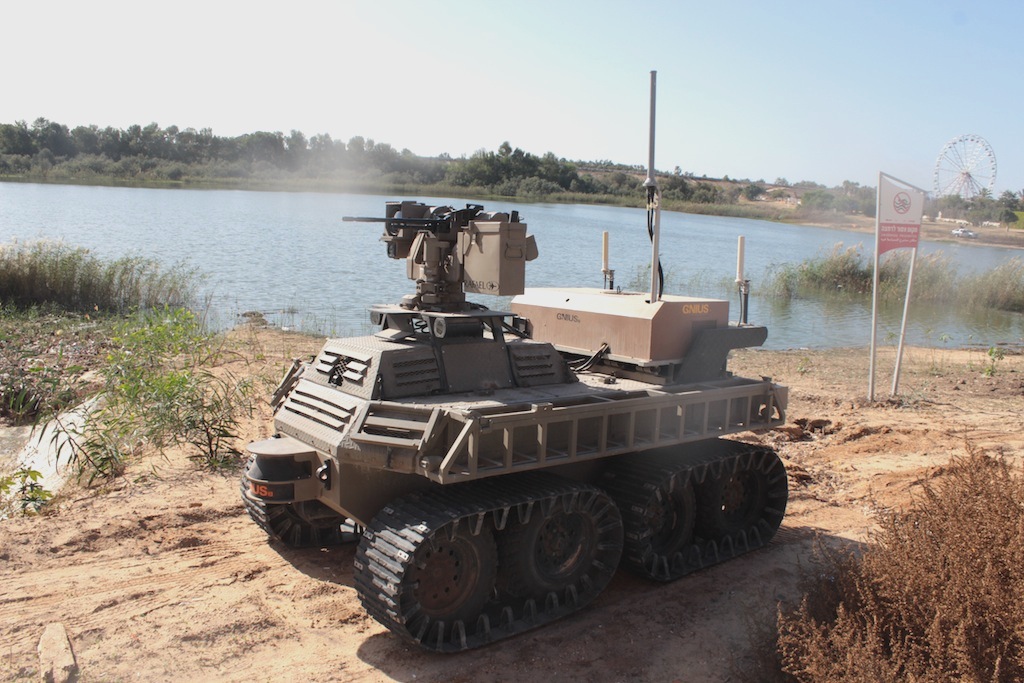
By Andrew Beale
On November 26, at the Cinema City Mall in Rishon LeZion, Israel, between the sunglasses stand and the entrance to the movie theater, exactly where you might expect to find a shiny new Nissan, a different kind of vehicle was on display for mallgoers: a 4X-UMI Heron I military drone.
The mall had been transformed into day-long drone trade show. The Heron I, manufactured by Israel Aerospace Industries, was one of the star attractions. The Autonomous, Unmanned Systems & Robotics convention, which had been organized by i-HLS Magazine, an Israeli homeland security trade publication, was the first of its kind to be held in Israel.
The Cinema City Mall was a surreal backdrop for the show; drones hung from the ceiling in front of movie posters advertising action thrillers and children’s cartoons. Many businesses, including several restaurants, a jewelry kiosk and the sunglasses stand next to the Heron I, were open for business. Indeed, some of the attendees even brought their children to watch the Heron I and other drones fly over a nearby ferris wheel.

In a way, the setting suited the conference’s focus on civilian applications of drone technology. In a presentation in front of a movie theater, David Oroshnik of Velodyne, a company that develops sensors for drones, talked about the potential for drones to be used as camera platforms in Hollywood films. Later, representatives from Israel’s Civil Aviation Authority spoke about the challenges facing civilian companies that wish to obtain permission to fly drones in Israeli airspace. As an example, the representatives explained that before issuing a license, the Civil Aviation Authority needs to determine when and if companies can fly drones through military airspace
Despite the focus on civilian applications, military technology was, of course, also amply represented among the exhibitors. Most of the companies at the show produced military systems, and many attendees donned full Israeli Defense Force uniforms. This lent the show an air of secrecy that is not uncommon for military conventions. Every company representative that I interviewed declined to comment on their proportion of military to civilian customers.
Nevertheless, the technology spoke for itself. The HydroCamel, an unmanned submarine developed at Ben Gurion University, provides a good example of the integration of military and civilian uses for drone technology. A brochure handed out at the HydroCamel booth features a cute cartoon of a camel wearing a snorkel and the tagline “The first autonomous submarine in Israel came from the desert.” A display board next to the HydroCamel boasted of its maneuverability, range and mapping capabilities, as well as its ability to fire torpedoes.

HydroCamel Project Director Guy Kagan explained the drone is not for sale; rather, it was on display at the conference to attract sponsors for the project. “The main idea is to use (the HydroCamel) for oceanographic research,” Kagan said. “You can take it to the Army side, but I can’t talk about that.”
Also on show was Uvision’s WASP UAV, a lightweight, single-use drone that can be carried in a backpack and launched from a lightweight tube. Uvision’s Amit Morag said the drone is primarily intended for reconnaissance but can be fitted with a warhead for “a suicide mission.” “The WASP can be used in some commercial applications,” Morag said, such as firefighting and monitoring gas pipelines. Meanwhile, a representative from 3D printer manufacturer Stratasys delivered a presentation on how 3D printers can be used to create drone parts. This idea has obvious civilian as well as military applications—3D printers can quickly and cheaply produce useable wings and body parts for almost any type of drone.
The blend of civilian and military customers at the show heralds a new phase in the integration of drone technology into the mainstream. A little later during the conference, businessmen, military officers, children and mall employees gathered outside the mall to watch the Heron I demonstration. A live feed of the drone’s camera showed the Heron I chasing kufiya-wearing actors. Nobody seemed particularly bothered by the fact that this single platform combined farming and firefighting technologies with targeted-assassination capabilities.

Last week, the Center’s Dan Gettinger wrote about the potential for drones to transform the way wars are fought. If the AUS&R conference was any indication, we may be looking at something even bigger: a revolution in the way we think about weaponry and even technology in general. Israel, which is the birthplace of advanced military drone technology, will become a focal point for the integration of military unmanned systems into the civilian sphere. As the same drones are increasingly used to spray pesticides and drop bombs, track insurgents and fight fires, the idea of military technology entering civilian life—not to mention civilian airspace—will become increasingly normalized. It may not be long before a drone replaces a Nissan at your local shopping mall, too.
Photographs by Andrew Beale.
[includeme file=”tools/sympa/drones_sub.php”]

Pingback: Weekly Roundup 12/2 | Center for the Study of the Drone